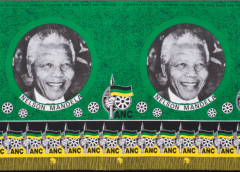
In An Epic V&A Exhibit Of Fashion From Africa, The Sartorial Is Political
[ad_1]
Standing before the people of Ghana to declare his nation’s independence from the British Empire, Kwame Nkrumah chose to set aside the bespoke Savile Row suits he customarily wore in public. Instead, he donned the traditional kente cloth of West Africa, adding sartorial elegance to his eloquent speech.
Nkrumah’s midcentury fashion statement provides an apt preamble to an extraordinary new exhibition at the Victoria and Albert, one of the museums where the British once denigrated African achievements. Africa Fashion features spectacular garments by forty-five of the continent’s leading designers – from Shade Thomas-Fahm to Chris Seydou to Thebe Magugu – but it’s more than a mere showcase of their acumen because African garments hold more than just spectacle in their folds. Although clothing everywhere functions as a form of communication, Africa is especially notable for the depth of significance, and for a lengthy history of being misunderstood by outsiders.
ANC Nelson Mandela commemorative cloth, South Africa, 1991. © Victoria and Albert Museum, London
The meanings woven into kente are characteristic of the communicative power and subtlety found in clothing across Africa – from Johannesburg to Bamako – and Kwame Nkrumah was a communicator par excellence. On the night he declared Ghanaian independence, he wore a pattern called The art is finishedmeaning “I have done my best.” Six years earlier, when his party first advanced in an election and he was released from prison, the cloth he chose had a pattern known as Damagesignifying “something that has not happened before”. In both cases, the geometric patterns Nkrumah chose were Asante, and carried the mark of royalty because kente was historically worn exclusively by Asante chiefs. When appearances mattered most, the future first president of Ghana knew that Savile Row tailoring was too vague.
As the curator Roslyn A. Walker observes in her essay for the Africa Fashion catalogue, kente is just one of “hundreds if not thousands” of textiles found on the second most populous continent in the world. Some of these are immediately legible to anyone from Europe or North America, at least in general terms. For instance, commemorative cloth is commonplace throughout Africa, printed commercially to celebrate events such as the release of Nelson Mandela or Barak Obama’s visit to Kenya. The cotton fabric is typically screen-printed with photographs and flags, fringed with text to reinforce the message.
Design by Chris Seydou. ©Nabil Zorkot
Other textile designs are so private that their full meaning may be known only to the person wearing them. This is notably the case with bògòlanfini, otherwise known as mud cloth because the decorated fabric is colored with fermented iron-rich mud. Dating back at least ten centuries and associated primarily with the Bamana of Mali, bògòlanfini was traditionally worn by women during rites of passage, conferring protection on the wearer. The hand-drawn designs appear geometric, but are actually comprised of symbols representing animals, places, and figures from mythology. While this vocabulary is widely known within the community, the significance embedded in their combination is as personal as a dream.
You wouldn’t know this if you saw Oscar de la Renta’s Spring/Summer 2008 collection, which featured bògòlanfini-inspired patterns printed on fashionable dresses and skirts. You probably also wouldn’t pick up on Basmana cosmology from the mud-cloth patterning on upholstery imported from China. In fact, the designs would be equally inscrutable to someone from Mali, since the similarities to traditional textiles are merely stylistic. Nothing is being communicated.
The curators of Africa Fashion are sensitive to the dynamics of cultural appropriation. In her impassioned prologue to the catalogue, the playwright Bonnie Greer calls appropriation an act of erasure, in the same vein as enslavement and colonization. “They are the principal grand attempt at re-remaking and forgetting,” she writes.
But even as appropriation has been condemned far and wide, all too little effort has been made to define it, and to distinguish it from positive cultural exchange. The trivializing of bògòlanfini stands as a good example of erasure because it ignores meaning and denies meaningfulness. Cultural illiteracy is an insult – and often an assault.
Nobody would claim that every African designer approaches heritage with the diligence of a scholar. The art is finished does not always mean “I have done my best”. What matters is that present garments designed and made in Africa are created in dialogue with the past, as are many garments originating in the African diaspora by designers such as Virgil Abloh.
People who don’t share a particular nationality or ancestry can also enter into these dialogues if their engagement is genuine. Cultural exchange is the opposite of erasure. Africa Fashion invites countless new conversations.
[ad_2]
Source link


